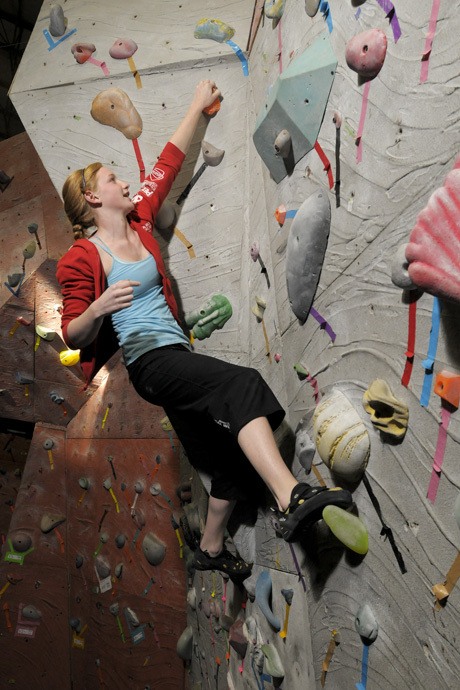For Islander Shannon Russell, 15, clinging with the tip of her extraordinarily long fingers to a chunk of plastic some 12 feet or more in the air is a natural thing.
Russell, a sophomore at Mercer Island High School, is a climber — but not the social kind. She spends her free time climbing rocks and walls.
It is an avocation that gives her more than strength. It gives her lessons in competition, strategy and focus.
Russell discovered the sport as a fifth-grader when she was living with her family in San Francisco. She began training in earnest in the seventh grade.
As her climbing grew into a passion, it all made sense, her mother said. Her daughter has always had an affinity for climbing, Pamela Russell said. When Shannon and her older sister were small, their parents put up a swing set in the backyard. The first thing that Shannon did was not get onto a swing, but to climb on top of the set, she said. She loved to climb trees, scaring a succession of nannies. The sport became another extension of her athletic self.
But just what is the sport of climbing beyond scaling mountains and cliffs?
The sport evolved into what it has become today from mountain climbers who trained by practicing certain moves over and over on a man-made structure.
There are three types of basic competition in climbing.
The first is free climbing, which entails only using your body to ascend a climb; ropes or harnesses are there just for safety reasons.
Next, bouldering is the art of free-climbing giant rocks, sometimes referred to as glacial erratics, whether it be in a desert, a rock at a climbing gym or a large stone at a shopping center or REI.
Bouldering is done at very low heights so that just a mat is placed on the ground to break a fall. The difference is clear when you look at the size difference between the two objects. The Vertical World Web site explains it this way: “Sometimes the line between bouldering and climbing blurs, but the general rule is that if the rock isn’t an intrinsic part of the mountain, or if you can fall without being killed, it counts as a boulder.”
Finally, speed climbing is a sport where participants are scored on how quickly they can conquer a climb or a boulder. Climbers are each given a set number of minutes to look over an ascent before starting out.
Climbing is equal parts technique and mind set, Russell said. The teen’s lanky build seems well suited to the sport. But she appreciates how her occasional fear and technique, born of hours of practice, make it work. Focus, rhythm and adrenaline are important parts of being successful.
It is perhaps surprising that such a singular pursuit is a team sport. Winners are declared on a points system. The scoring is determined by how far each individual gets up a route and how fast.
Russell competes with a team from her climbing gym. Russell and her team have had a good deal of success. The Vertical World team and Russell have taken top honors at local and national climbing events. The team has between 30 and 40 people of all ages. The competitions are against climbers from all over the United States. Ironically, Team Texas, from one of the flattest places on the planet, has the largest and most successful team of all with 50 members.
Russell is yet another example of a busy Island teen. Beyond climbing three nights each week for three hours, she often has swimming practice, other sports and, of course, school. She spent much of this past summer at the gym in between a nanny gig and working at a gym camp for younger kids. Her parents support her completely and take turns driving her back and forth. Russell will not be 16 until January — and then a license, well, maybe.
“Having all of these activities has helped me with my time management skills,” she said with a laugh.
The climber is the younger of two sisters. Her sister, Caitlin, is a senior at MIHS.
Russell was born in Virginia and lived with her family on Mercer Island for a time before her parents, both in the United States Coast Guard, were transferred to California. The family knew they would return here after both Pamela and Douglas Russell retired from the military.
Climbing is apparently a growing sport and is not just for fearless teens. “You see whole families,” Russell said, “parents climbing with the kids.”
The ages of her teammates range from very young to older adults, she added.
But it must be said that this sport can cause serious injury. It is dangerous and not recommended without some type of advance training.
Russell said she appreciates the risks. She said she has been afraid. But fear is a healthy thing. She has fallen. She points out that the heights are not that extreme. In particular, bouldering rocks are not high enough to get seriously hurt from a fall, she explained.
“It is not a big deal,” she shrugs. “But the fear teaches you.”
There are all kinds of safety measures in place. But the safe sense goes beyond physical well-being. It is what climbers like Russell and her mother call a ‘safe place to fail,’ a place where everyone encourages everyone else.
Russell said her closest friends are the ones on the Vertical team. It is a sport where self-confidence is born and nurtured.
Participants say it is a challenging way to stay in shape and is curiously seen as a way to relax. Climbers say the focus and concentration required to climb helps them let go of the clutter of everyday life and relieve stress.
For more information on climbing and the Vertical World Teams, go to www.verticalworld.com.


